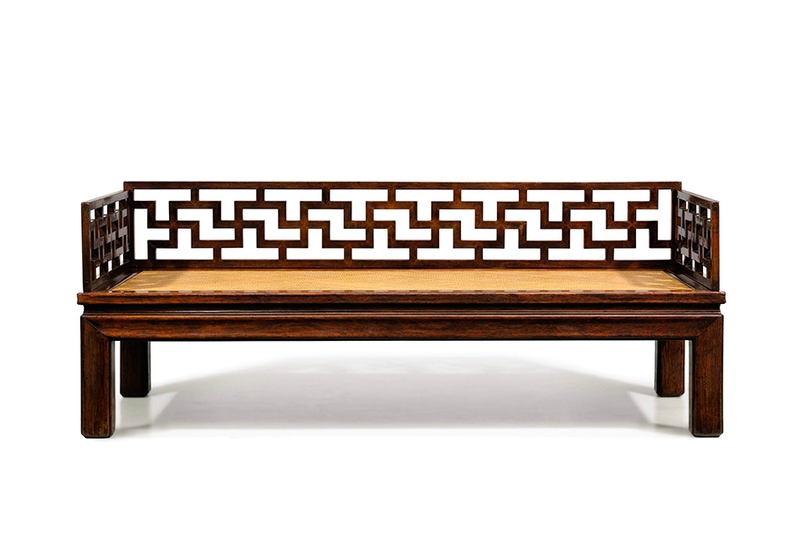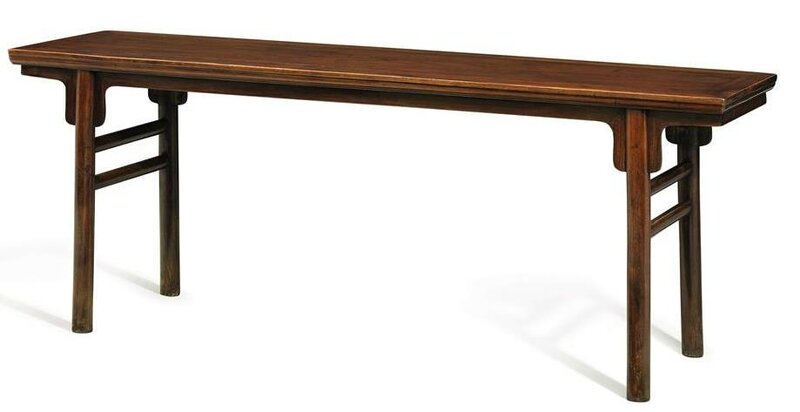Sotheby's Hong Kong to offer Ming furniture from an Asian Private Collection
Couch Bed Luohan Chuang, Huanghuali Wood, Late Ming (1573–1644); Width 206.5 cm / Depth 90.9 cm / Height 79.1 cm / Seat Height 47.3 cm. Photo: Sotheby's.
HONG KONG.- Following the ‘white-glove sale’ of Ming Furniture – The Dr S Y Yip Collection in October 2015, Sotheby’sHong Kong is honoured to offer Ming Furniture – An Asian Private Collection in the Chinese Works of Art Spring Sale series on 6 April 2016. The Collection is distinguished by its owner’s connoisseurship and keen interest in the history of Chinese furniture, as well as highly discerning taste. Every item in the collection was purchased from world-renowned Ming furniture dealer Grace Wu Bruce, each an outstanding example of its kind. Rarer still, most of the pieces offered have been widely published, their quality rivaling similar pieces in the world’s leading museums. Eight pieces of furniture and ten table-top pieces will be offered in a dedicated sale.
High Yoke-Back Armchair & Sloping-Stile Wood-Hinged Cabinet, Huanghuali Wood, Late Ming (1573–1644). Photo: Sotheby's.
Kevin Ching, Chief Executive Officer, Sotheby’s Asia, says, “Rare and high-quality Ming furniture has long been an important and refined collecting category for sophisticated collectors. The owner of this private collection studied fine arts in his youth and his taste and standard were extremely high. All the pieces in the present collection were purchased from Grace Wu Bruce. Grace is revered as ‘the Queen of Huanghuali’ in the world of Chinese furniture and her expertise and professionalism are reflected in the museum quality of each and every piece of furniture in this collection. Following the phenomenal success of Dr Yip’s magnificent furniture offered last year, Sotheby’s is delighted to be entrusted with yet another outstanding collection.”
HIGHLIGHTS:
FURNITURE
Couch Bed Luohan Chuang, Huanghuali Wood. Late Ming (1573–1644); Width 206.5 cm / Depth 90.9 cm / Height 79.1 cm / Seat Height 47.3 cm. Photo: Sotheby's.
This huanghuali couch bed is striking in its elegant form, with railings made of short members joined together to form the 卍 wan pattern, a popular decorative motif of the Ming period. The recessed, low foot pads form an ingenious finish for square legs at the ground level, almost imperceptibly elevating the entire bed. Luohan beds with backs and arms composed of small members mitred and mortised together dated to late Ming and early Qing are exceedingly rare. These important works of craftsmanship are testaments to the refinement of Ming carpenters’ art.
Sloping-Stile Wood-Hinged Cabinet, Huanghuali Wood, Late Ming (1573–1644); Width 88.7 cm / Depth 44.5 cm / Height 157.2 cm. Photo: Sotheby's.
This magnificent huanghuali cabinet features matching door panels cut from the same timber, with a tightly-grained, whirling pattern showcasing huanghuali wood at its best. Preserved in superb condition, the cabinet features original metalware; its original ramie, clay and lacquer coating (on the inside and rear of the cabinet) remain almost completely intact. The sloping-stile wood-hinged cabinet is one of the most ingenious and beautiful designs of classic Chinese furniture. The four main stiles are recessed from the corner of the top, sloping gently outward in a subtle splay. This simple design feature gives the cabinet its refined elegance and a sense of balance and stability. With wood-hinged doors, the clean lines of the cabinet are free from the interference of applied hinges—another attribute making slopingstile wood-hinged cabinets true masterpieces of Chinese cabinet making.
High Yoke-Back Armchair, Huanghuali Wood, Late Ming (1573–1644); Width 58.3 cm / Depth 45 cm / Height 115 cm. Photo: Sotheby's.
High yoke-back armchairs are perhaps the rarest type of chair in surviving examples of Ming furniture. The name ‘yoke-back’ armchair derives from the resemblance of the chair’s top rail to the yoke placed across the necks of oxen pulling a plough. Made of choice timber, chairs of this design can be seen in woodblock illustrations to Ming period novels. The centre of the top rail, vigorously shaped with fluid curves, is carved to serve as a headrest—a standard feature of high quality yoke-back armchairs.
Pair of Large Horseshoe Armchairs, Huanghuali Wood, Late Ming (1573–1644); Width 61.6 cm / Depth 47.6 / Height 102 cm. Photo: Sotheby's.
One of the three primary types of Ming chairs, the horseshoe design is uniquely Chinese and has inspired leading 20th-century furniture designers to create wellknown modern examples. This completely plain pair of horseshoe armchairs with fluid curves and simple lines is distinguished by their purity of form. Larger and taller than standard examples, they were likely reserved for the master of the house and senior guests in the Ming period.
Pingtouan Table, Huanghuali Wood, Late Ming (1573–1644); Width 205.8 cm / Depth 53.8 cm / Height 79.2 cm. Photo: Sotheby's.
This classic design has its origin in ancient Chinese architecture made of wood. Completely plain, this simple form with pure lines is what first captured the attention of 20th-century furniture historians. This pingtouan (flat-end) table of near perfect proportions, crafted in choice timber of warm orange-brown tone with a well-figured single-panel top, is an example of the best of classic Ming furniture.
TABLE-TOP PIECES

Box, Huanghuali Wood, Late Ming to early Qing (1600–1700); Width 40 cm / Depth 22.2 cm / Height 14.9 cm. Photo: Sotheby's.
This small box is meticulously hewn in highly figured, beautifully grained huanghuali wood. Reinforced with think metal mounts, this sturdy box is suitable for storing heavy-weight treasures. The functions of these boxes were manifold, ranging from the storage of documents and seals to valuables like jewellery, silver and cash.

Miniature Qiaotouan Table, Huanghuali Wood, Late Ming to early Qing (1600–1700); Width 35.8 cm / Depth 11.4 cm / Height 11.6 cm . Photo: Sotheby's.
Constructed in a similar manner to its large-scale relations with single plank top, everted ends, cloud-shaped spandrels and openwork inset panels between legs with splayed feet, these miniature tables were used in the scholars’ studios as desk displays or stands for precious objects.

/https%3A%2F%2Fprofilepics.canalblog.com%2Fprofilepics%2F1%2F0%2F100183.jpg)
/https%3A%2F%2Fstorage.canalblog.com%2F03%2F02%2F119589%2F96711876_o.jpg)
/https%3A%2F%2Fstorage.canalblog.com%2F11%2F31%2F119589%2F94773502_o.jpg)
/https%3A%2F%2Fstorage.canalblog.com%2F20%2F83%2F119589%2F94772815_o.jpg)
/https%3A%2F%2Fstorage.canalblog.com%2F26%2F72%2F119589%2F75604929_o.jpg)
/https%3A%2F%2Fstorage.canalblog.com%2F59%2F60%2F119589%2F26458628_o.jpg)









/http%3A%2F%2Fstorage.canalblog.com%2F94%2F30%2F119589%2F128547808_o.jpg)
/http%3A%2F%2Fstorage.canalblog.com%2F47%2F05%2F119589%2F109910921.jpg)
/http%3A%2F%2Fstorage.canalblog.com%2F63%2F62%2F119589%2F129821675_o.jpg)
/http%3A%2F%2Fstorage.canalblog.com%2F70%2F10%2F119589%2F121477193_o.jpg)